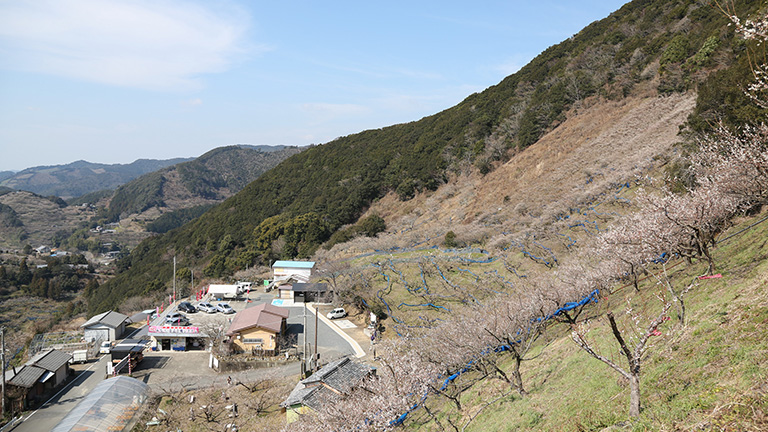The Mitsui & Co. Environment Fund
Introduction to Grant Projects
Wakayama University Faculty of Systems Engineering Associate Professor: Yuji Hara
Sustainable land-use management models based on the relationship between the landscape heritage and plant diversity at the Minabe-Tanabe GIAHS Ume System
Research grant
- Project Description
In the Minabe-Tanabe region of Wakayama Prefecture, ume trees have long been planted for ongoing production of ume plums. At the same time, the fuelwood forests of the mountain ridges have been retained. Fuelwood forests function in a way that enables water conservation and prevents landslides. The ume and fuelwood trees are a source of pollen for Japanese honey bees, and the bees have continued to play a role in the pollination of the ume. The ecosystem is working in perfect harmony in this environment, where most of the ume trees were introduced by humans. Recognizing this point, the area was certified as a Globally Important Agricultural Heritage System (GlAHS) by the Food and Agricultural Organization of the United Nations. This project aims to clearly visualize the composition and structure of the vegetation and ecosystem of this area, and present it globally as a model for sustainable land-use management. Additionally, a regional ecosystem monitoring system will be developed following discussions with stakeholders. This will also be presented locally and internationally. [No. R16-0021]
- Fields
- Ecosystems and the Symbiotic Society
- Grant year
- FY2016 Research Grants
- Grant term
- 3 years
From April 2017 to March 2020
- Grant amount
- 5.5 million yen
- Activity region
- The GIAHS certified Minabe-Tanabe Umesystem area in Kinan, Wakayama Prefecture

Overview of the Organization

- Representative
- Associate Professor: Yuji Hara
Faculty of Systems Engineering
Wakayama University - Area of specialty: Landscape ecology
Academic affiliation: The Association of Japanese Geographers, Japanese Institute of Landscape Architecture, Rural Planning Association, Japan Society of Civil Engineers
CV (work history, academic qualifications): After graduating from the School of Science at the University of Tokyo in 2001, began research on green space environment and ecosystem services in suburban areas in Asia, at the University of Tokyo's Landscape Ecology & Planning Lab. Conducted on-site research in Japan, Thailand and the Philippines. Left his doctorate course in 2005 and became a Specially Appointed Assistant Professor at the University of Tokyo, where he conducted ongoing research conditions relating to regional ecosystem management based on a recycling society. After compiling the results, acquired a doctorate (Agriculture) in 2007. Moved to Wakayama University in 2009, and began research on ecosystems in undeveloped woodlands around regional cities and low mountainous areas. Became involved in the Minabe-Tanabe GIAHS application as an expert in 2014, and provided international support including assisting with the application document for submission to the FAO.
Following the certification, expressed the intention to continue further research on the region's ecosystem, which led to the application for this research grant. - Recent Activities
-
- Hara, Y. (2017): An introduction to the Minabe-Tanabe Ume System in Japan as newly recognized FAO GIAHS site: and overview of the application process as an exercise in stakeholder consensus building. FAO GIAHS African Regional Workshop (invited).
- Yuji Hara, Yuki Sanpei (2016): Minabe-Tanabe Ume System — The unique landscape and the real selection process. Rural Planning Association Journal 35(3), 379-382.
- Seichi Tani, Yuji Hara, Yuki Sanpei (2016): Sakai City Kyu-Nodamura area urbanization and the resulting changes in waterways and farmlands and effect on the habitat of frog breeds. Journal of Environmental Information Science 30, 237-242.
- Yuji Hara, Tasuku Osugi, Kensuke Yokoo, Yuya Oda, Dai Fukui, Toshiaki Takenaka, Satoshi Arimoto (2015): The habitat and activity range of the Japanese pond turtle in Mouko Fudo-tani Kainan City Wakayama Prefecture, and their relationship with other turtle species. The Nanki Biological Society 57(2), 97-106.
- WEB site
- http://future-landscape.com